TREVALLY ON LURES
By Sam Mossman
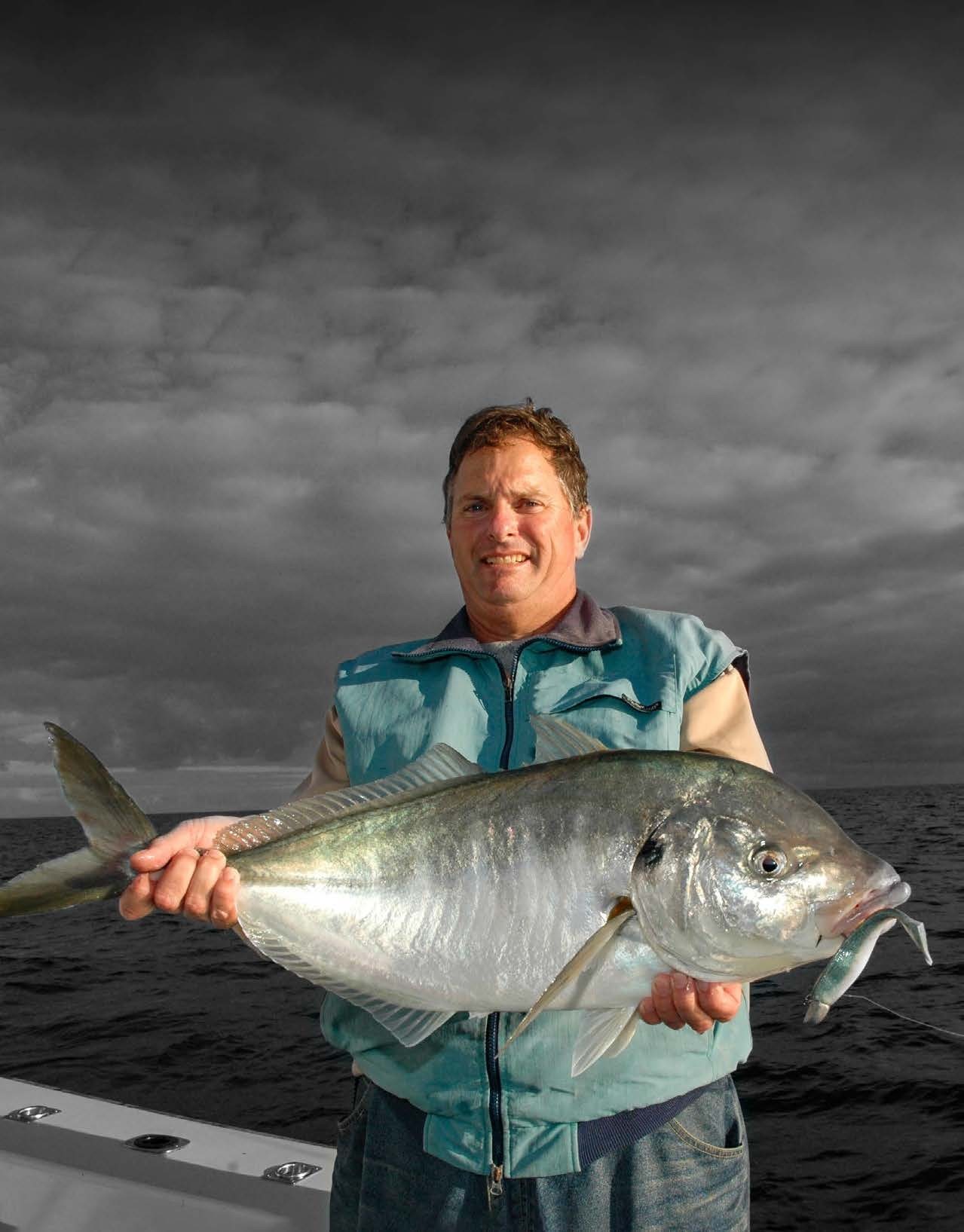
Sam reckons he has caught more big trevally in the last 10 years on softbaits fished over open bottoms than by any other technique. A nice one from the Hauraki Gulf.
I love fishing with lures and sometimes wish we had a wider range of medium-sized sportfish species available in New Zealand. But then again, with modern lure techniques, a great many species that were once considered only able to be caught with bait are now regularly taken on artificial lures of one type or another. As most fish make a living by eating other types of marine animals, it is really only a matter of finding the right buttons to press.
One of my favourite sport and table fish is the trevally. Although there are something like 150 members of the trevally, jack and mackerel clan (the Carangidae) worldwide, in local waters trevally are represented by a single species. Our white or silver trevally is a slow-growing, long-lived species and some large specimens have been aged at over 45 years by using the annual growth rings in their ear bones.
I once photographed and witnessed the weighing of the current national all-tackle record trevally of 11.53kg. That was a gnarly old fish from Great Barrier Island, approaching a metre in length, but it was exceptional. Usually, anything between three and four kilos is thought of as a decent fish, with anything over 5kg considered a trophy.
Because of this slow growth and their surface-schooling behaviour, purse seiners have had a huge impact on trevally numbers. Starting around 1970, purse seine net boats hit trevally hard. Gone are the shining acres upon acres of trevally surface schools that I can remember seeing during visits to the Bay of Plenty as a child, with only smaller, scattered groups of spooky fish encountered these days, mostly over areas of heavy foul where the net boats cannot operate.
Rocky headlands and points that concentrate currents also concentrate plankton and krill and are good places to look for schools of these fish. Sometimes, larger individuals are mixed in with other school fish including snapper or kahawai, feeding on sedimentary bottoms, especially in autumn. During the colder months, trevally can be found spread out up in harbours and estuaries.
Trevally are a handsome fish. Colour schemes can vary a lot between individual fish in shades of silver, grey, olive, blue, gold, and white, sometimes with pale vertical stripes when fresh. This variation raised the question of whether there were several species in New Zealand. The guys that curate the national fish collection at Te Papa once asked me to collect some specimens of differently coloured trevally for investigation, but they all turned out to be the same single species.
“ The current national all-tackle record trevally of 11.53kg... was a gnarly old fish from Great Barrier Island... ”
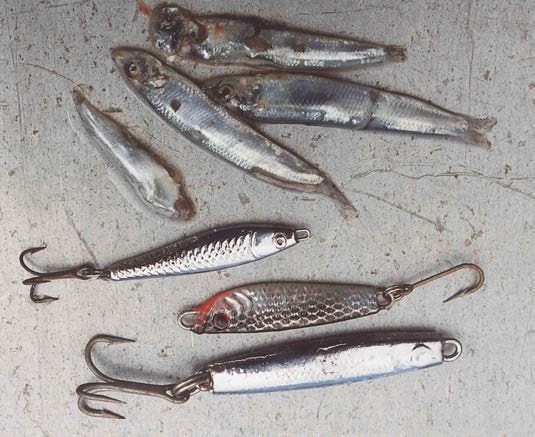
Small metal lures match these little anchovies well and will hook trevally – with the correct technique.
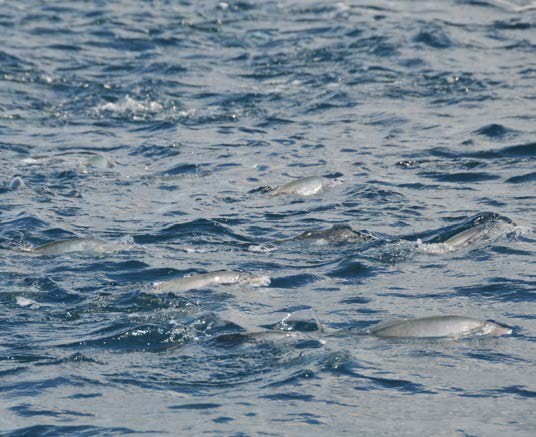
Surface feeding trevally slurping down krill.
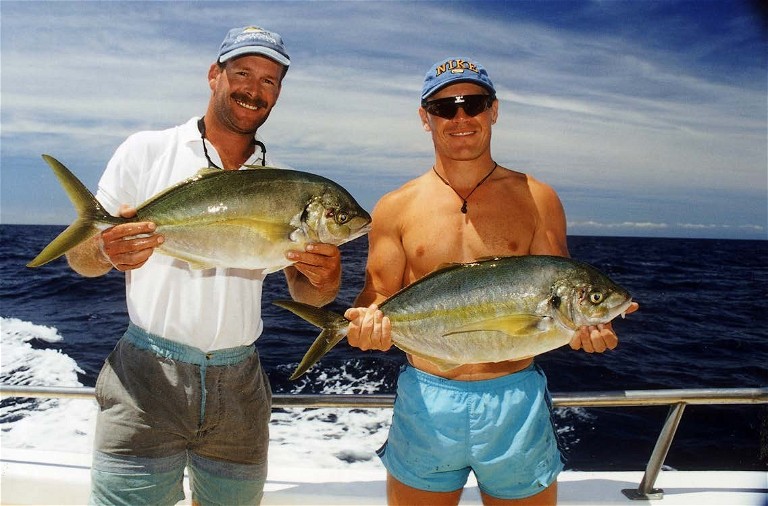
White Island is known for its big trevally. Ross Grieve and Al Mair with a fine pair.
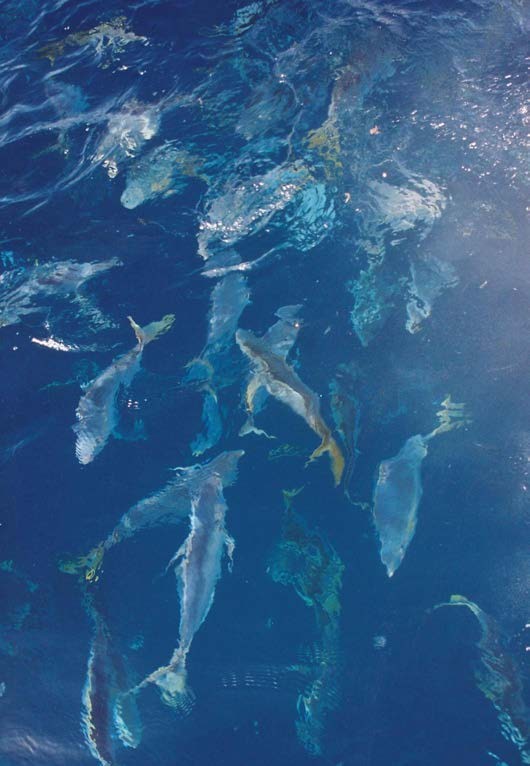
Trevally are berley hogs and can be lured into easy fly-casting range with a berley trail.
As they age their body form alters (just like humans!). They tend to develop a more pronounced hump on their heads, and their lips get tougher and thicker. This makes for better hook holds and less chance of pulling the hook from big fish than from smaller fish, which are considered to have ‘soft mouths’. These larger fish also start to feed on bigger prey, including squid, medium-sized baitfish and crustaceans. This makes them easier to hook on larger lures.
Like their cousins the kingfish, trevs are powerful fighters and will often head straight for cover if there is any around. Any angler who has tried to extract a decent trev from near a kelp bed or around oyster-studded wharf piles will know what I mean. They get that broad silver flank side-on and slug down to the obstruction. If you don’t have the firepower to stop them (often you must go to light line to get a take in the first place), it is all over.
I have caught trevally on metal jigs in the Marlborough Sounds, and they are reported as far south as Foveaux Strait, but the best numbers of them are to be found in the north half of the North Island.
There are not many surface schools of big, old, hump-headed trevally around these days, with commercial pressure resulting in these groupings being mostly smaller, younger fish, but one of the more dependable assemblies of these old warriors is at White Island, where many of the national record captures have been made.
Other hot spots for trevally include the Coromandel, the Hauraki Gulf, and most of Northland, on both coasts. Some large individual fish are taken around offshore islands and headlands by landbased fishermen who tramp to more remote locations, but extracting these tough fighters from rocky terrain is, as mentioned, not particularly easy. There are some monster trevs around the Three Kings Islands, too, and these are sometimes targeted by those chasing records on light tackle and saltwater fly.
Trevally on jigs
Trevs are a relatively common catch on cut baits. A ledger rig with a small bait of squid, shellfish or a pilchard cube, or a flasher rig (particularly when sweetened with a sliver of bait) will do the job, as will small, lightly-weighted or unweighted baits drifted down a berley trail. However, they can be challenging fish to take regularly on lures and many anglers put lure fishing in the too-hard basket, reverting to jagging with huge treble hooks ripped through the school if they want to put one in the bin.
Seasonally, trevs can be found in the warmer months feeding on the surface in schools, usually taking krill (small shrimp-like creatures) or sometimes larval fish. Light-tackle spin gear can be an effective weapon in this situation, but correct presentation of a very small metal jig lure is important.
Surface schools feed in one direction and the important part is to cast your little lure in front of the leading edge of the school and retrieve at a medium-fast speed. The ideal is when the lure intersects the front of the school as it feeds forward, so that the lure appears to be fleeing from the trevally, not charging toward it. Pretty regularly, this results in a trevally fair-hooked in the mouth. However, if you just fire your lure into the middle of the school, or over it, the fish will mostly spook and submerge, or you will foul-hook a fish which is difficult to handle on light tackle and often lost when the hook tears out. Although developed using monofilament, this method still holds good with modern, fine braid lines and the latest in miniature metal jigs and mini stickbaits.
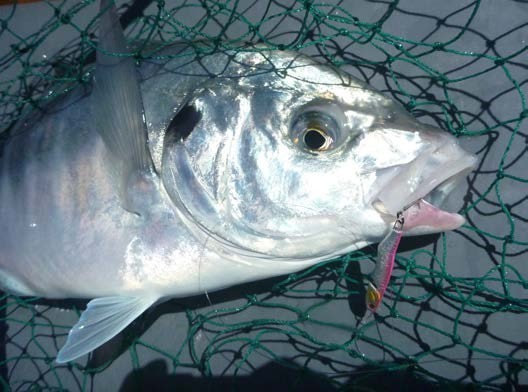
Small jigs, fished correctly, will provide fair mouth hook-ups.

Surface feeding trevally are often taking krill.

A five-inch soft bait produced this fine trevally for Mike Clay.

2) Big trevally have no trouble slurping down a big softbait.
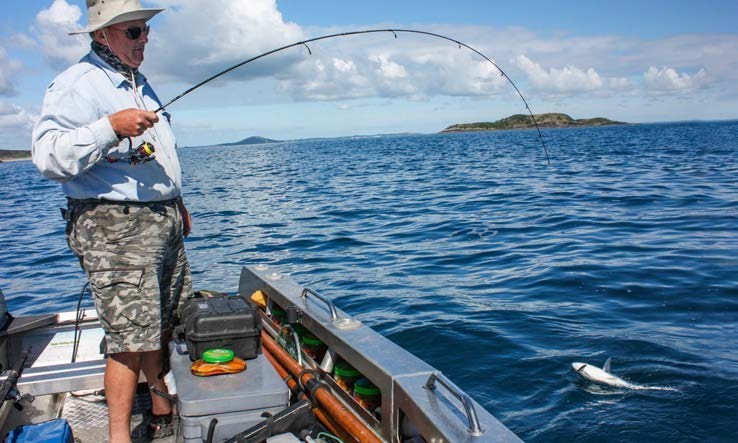
3) Ultralight tackle, in this case 2kg, is great sport with trevally.
One of the reasons for needing light gear (3-4kg) is that the small lures required for this fishing are difficult to cast any great distance with heavier tackle – and you want to stay some distance away to avoid spooking the school.
The other side of this coin is that heavier, thicker line is easy for fish to see in well-lit surface water and trevally can be line-shy at times. It is noticeable that they are easiest to hook, especially on heavier lines, either early or late in the day (when the light and visibility are low), or when they are holding deeper down in the water column where light levels (and visibility) are reduced.

4) Present your lure to the leading edge of surface feeding schools for best results.
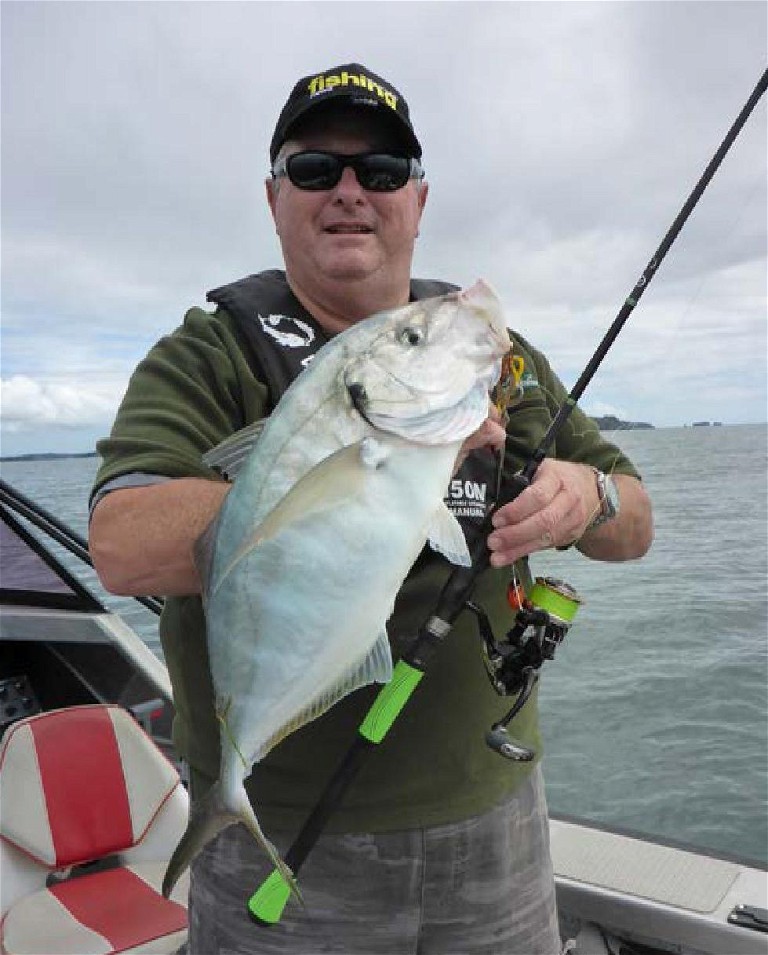
Sam with a nice softbait victim from Northland.
Going soft
During the autumn, large individual fish seem to spread out over sedimentary bottoms, grubbing for molluscs, shellfish, worms and whatever else they come across. This is where softbaiting is particularly effective. I don’t have any way of specifically targeting trevs with softbaits as it can be a generalist method (during a recent trip I caught a mix of snapper, kahawai, trevally, gurnard and john dory for example), but there are usually some decent trevs feeding amongst the other species at this time. You will just have to put up with catching these other species until you hook a trevally. Damn! However, it is fair to say that I have caught more big trevally in the last 10 years on softbaits fished over open bottoms than by any other technique.
A four-inch grub or fiveinch paddle tail or jerk shad in ‘natural’ colours fished along the bottom is a good place to start. And the best part is, when you hook a monster trev on an open sedimentary bottom, you have every chance of landing it, even on very light tackle. The lighter tackle forces you to take it easy when playing these strong fish to avoid a bust-off. In turn, this ‘softly, softly’ approach helps avoid pulling hooks on this softmouthed species, and provides a very satisfying fight.
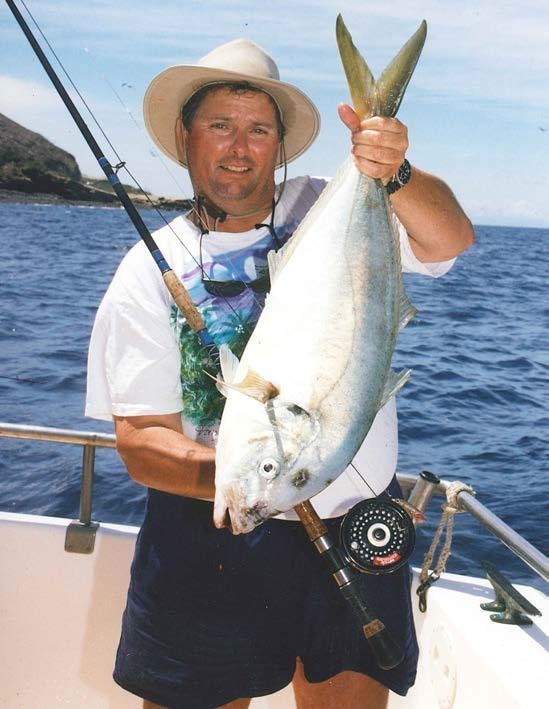
Sam with a flyrod trevally from White Island, a national record on 6kg tippet for many years.

Shrimp-like flies are the answer to krilling trevally. The late Doug Rankin with a Cape Karikari fish.
On flies
As mentioned, during the warmer months trevally can be found feeding in surface schools, usually on shrimp-like creatures called krill, or larval fish including small anchovies during their northern autumn inshore run. I have caught plenty of trevally over the years from surface schools on small flies. Shrimp-like flies of the ‘Crazy Charlie’ type, or small streamers, are good patterns in this situation, again fished to the leading edge of the school.
Trevally are real berley hogs. Think of them as the Labradors of the fish world. A good berley trail can be key to bringing the fish in to where they are easily reached with flies. Glow bug types or berley flies work well in this scenario, but small Clousers minnows or streamer pattens work, too.
Eating qualities
There are still some who think that trevally are poor eating and best used as bait. I think this concept dates back to the days when packets of Wattie’s Trevally Bait were one of the very few retail bait options that were available to recreational fishermen.
These days, most people are much more appreciative of the trevally’s eating qualities. Personally, I love them as a table fish, preferring them to snapper. They are firm, well-flavoured and when fresh, are highly regarded for sashimi and kokoda.
Having a decent growth potential, these hard-fighting, good-looking, good-eating fish often take a bit of finesse to beat. I reckon that a decent trevally is close to the perfect inshore opponent; you can have your sport and eat it, too!

Trevally added to IGFA record categories
New Zealand’s (also found in Australia) white (silver) trevally (Pseudocaranx dentex) has just been added as a new entry across Line Class, Tippet Class, Junior, and All-Tackle Length to the International Game Fish Association’s (IGFA) World Record categories. This introduces 36 new open record categories. The minimum length for the All-Tackle Length categories is 55 cm.